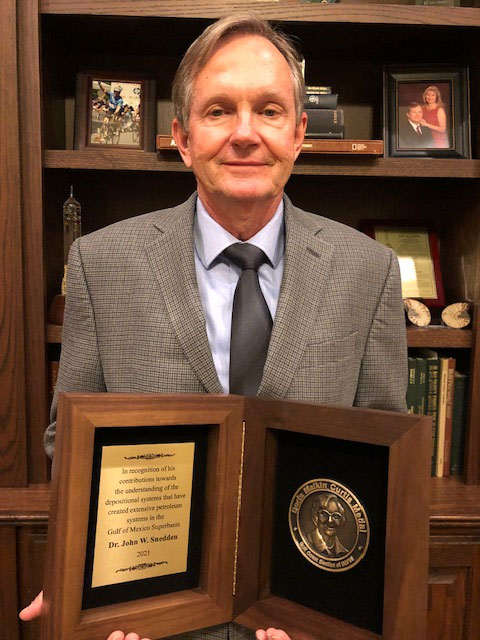John Snedden
2021 Doris Malkin Curtis Medal

The Gulf Coast section of SEPM’s Doris Malkin Curtis Medal recognizes geologists for their career contributions to the development of new concepts for understanding the geology of the Gulf of Mexico Basin and other basins globally. The award is named in honor of Doris Malkin Curtis, one of the pioneers of Gulf Coast paleontology and stratigraphy. This year’s Doris Malkin Curtis medalist is John Snedden. GCSSEPM is recognizing John for his contributions to the understanding of the depositional systems and extensive petroleum systems in the Gulf of Mexico Basin. John is the Director of the Gulf Basin Depositional Synthesis Project (GBDS) in the Institute for Geophysics at The University of Texas at Austin. In 2019, John and GBDS-founder Bill Galloway published “The Gulf of Mexico Sedimentary Basin”—a landmark volume that encapsulated decades of work by John, Bill, their students, and their colleagues at UT Austin.
John’s close ties to Gulf of Mexico geology go back to his undergraduate work at Trinity University in San Antonio and his Master’s degree at Texas A&M University working on lignite deposits of south Texas. John took a break from the academic life to work for Mobil Oil for 4 years in Houston where he worked on production in Texas and New Mexico and did a stint of fieldwork in Arizona.
In 1983, John took a leave of absence from Mobil to return to academia. He did his PhD research at LSU working with Dag Nummedal on modern shelf sediments of the Texas coast. This work led to influential papers on the storm and fair weather transport of sand across the shelf. In the 1980’s the formation of shelf sandbodies as reservoirs was a topic of much interest and controversy in sedimentary geology. John’s work on the modern Texas coast landed him right in the middle of this question. He continued to contribute to the understanding of shelf sandbodies with work on the New Jersey shelf and the publication of several more papers after re-joining Mobil.
Mobil got John out of the Gulf Coast with a job in Stavanger, Norway where he worked on deltaic and shallow marine reservoirs in the North Sea and Nigeria. In 2000, he returned to Houston just in time for the Exxon-Mobil merger. Many of Mobil’s stratigraphers had retired or left ExxonMobil at the time of the merger. John stayed and prospered. He was the skill area coordinator for stratigraphy, a job not for the faint hearted given the outsized personalities of many Exxon stratigraphers at the time. I got to know John when we were working on a new, multi-disciplinary reservoir connectivity project at ExxonMobil Research. John’s leadership and technical expertise were critical to the success of this project that not only led to several papers and patents, but more importantly to valuable new reserves found in and around existing fields. The success of reservoir connectivity analysis led to it moving out of the research lab and into the business units. John moved to Germany to open a new chapter in his career by working on unconventional resources.
Ten years ago, John made a major career change by retiring from ExxonMobil after returning from Germany and taking over the Directorship of GBDS. Bill Galloway founded this program in the 1980’s working primarily with well logs and biostratigraphy to reconstruct the depositional history of the Gulf of Mexico Basin. John very successfully built on this foundation by adding seismic data and expanding the project into Mexico just as Mexico was opening up their oil industry to outside investment. His research interests since joining UT have not been restricted to petroleum geology. He has, for example, published on the Chicxulub impact and associated deposits of the KT boundary. The longevity of this consortium is a testimony to John and Bill’s contribution to Gulf Coast geology and their impact on both the petroleum and academic geology communities.
Having completed “Gulf of Mexico Sedimentary Basins” and a synthesis of the Gulf of Mexico Superbasin in the recent AAPG Bulletin Superbasins Special Issue, John is taking more time to enjoy hiking in the mountains of Colorado and escaping the hot Austin summers. Nonetheless, I am sure that he will continue to make important contributions to understanding the Gulf of Mexico.
Mike Sweet
